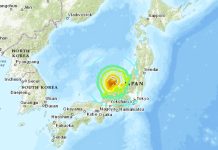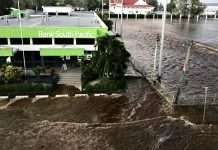
NUKU’ALOFA, Tonga, Jan. 15, 2022 (Gephardt Daily) — The eruption of a massive underwater volcano in the South Pacific sent a tsunami wave crashing into Tonga’s largest island Saturday, while triggering tsunami alerts across the region.
The eruption of the Hunga Tonga-Hunga Ha’apai volcano, about 40 miles north of Tonga’s capital of Nuku’alofa, was captured by satellites about 5:26 p.m. local time in a stunning display of power which was heard as far away as New Zealand and Australia.
The sound of the blast described as rolling thunder was also reported in Fiji.
While damage assessments are still being made video posted on social media shows the tsunami as it reaches the Tongan shore and pushes its way through the capital city, flooding streets, homes and other structures.
A wall of water also inundated the Palace Grounds, forcing Tonga’s King Tupou VI to evacuate.
1.14.2022: (correction on date) Large volcanic eruption near Tonga (Hunga Tonga-Hunga Ha'apai volcano) today as seen from outer space. Shown on visible imagery using the Himawari satellite. #hiwx #tsunami #earthquake pic.twitter.com/Y18W7wvXl9
— NWSHonolulu (@NWSHonolulu) January 15, 2022
The wave that hit the Tongan capital was measured at 2.7 feet, while a wave that reached Pago Pago, the capital of American Samoa, was about 2 feet, according to the Pacific Tsunami Warning Centre.
Tsunami videos out of Tonga ?? this afternoon following the Volcano Eruption. pic.twitter.com/JTIcEdbpGe
— Jese Tuisinu (@JTuisinu) January 15, 2022
A tsunami advisory was issued for the U.S. west coast, including California, Oregon Washington and Alaska, according to the NWS National Tsunami Warning Center in Palmer, Alaska. The NTWC reported a wave one-to-two feet high could reach the U.S. mainland between 7 a.m. and 7:30 a.m. Pacific Time.
Rising tides were already seen in the Hawaiian islands with only instances of minor flooding reported.
The Tsunami advisory is as follows:
* CALIFORNIA, The coast from The Cal./Mexico Border to The Oregon/Cal. Border including San Francisco Bay
* OREGON, The coast from The Oregon/Cal. Border to The Oregon/Wash. Border including the Columbia River estuary coast
* WASHINGTON, Outer coast from the Oregon/Washington border to Slip Point, Columbia River estuary coast, and the Juan de Fuca Strait coast
* BRITISH COLUMBIA, The north coast and Haida Gwaii, the central coast and northeast Vancouver Island, the outer west coast of Vancouver Island, the Juan de Fuca Strait coast
* SOUTHEAST ALASKA, The inner and outer coast from The BC/Alaska Border to Cape Fairweather, Alaska (80 miles SE of Yakutat)
* SOUTH ALASKA AND THE ALASKA PENINSULA, Pacific coasts from Cape Fairweather, Alaska (80 miles SE of Yakutat) to Unimak Pass, Alaska (80 miles NE of Unalaska)
* ALEUTIAN ISLANDS, Unimak Pass, Alaska (80 miles NE of Unalaska) to Attu, Alaska including the Pribilof Islands
The initial eruption lasted about eight minutes, but how long the volcanic activity will continue is unknown. Volcanic activity in the region often lasts for weeks or longer.
The blast sent a plume of ash and smoke over 12,000 feet high, impacting the weather throughout the region. Ash, mixed with rain, was reportedly falling across Tonga shortly after the eruption.
Gephardt Daily will update this developing story as more information becomes available.






